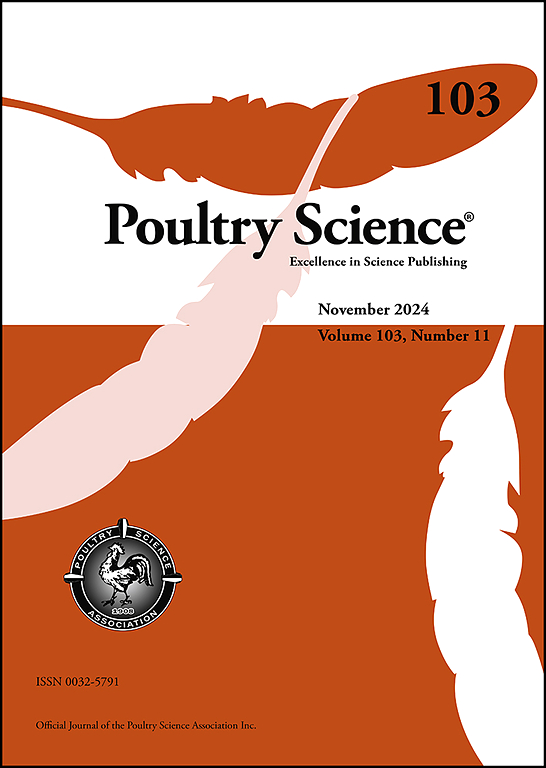过氧化大豆油对肉鸡生长和能量消化率的影响。
IF 3.8
1区 农林科学
Q1 AGRICULTURE, DAIRY & ANIMAL SCIENCE
引用次数: 0
摘要
过氧化脂质已被证明会降低肉仔鸡的生产性能,因此,从理论上说,饲粮过氧化值(PV)加茴香胺值(AnV)可以预测肉仔鸡的生产性能。试验1:64个栏(8只/栏)饲喂8个水平过氧化大豆油的饲粮。试验饲喂7 ~ 35日龄肉鸡,每个饲粮处理8个重复。与未加热的豆油相比,135℃处理的豆油降低了肉鸡的平均日增重(ADG)和平均日采食量(ADFI, P≤0.05);与未加热的豆油相比,90℃处理的豆油降低了肉鸡的料重(GF, P≤0.05)。总结这些数据发表的数据导致显著(P≤0.01)回归模型相对ADG (ADG % = 101.9 -(0.05×PV) -(0.30×AnV), SE = 4.1, R2 = 0.43), ADFI [ADFI % = 101.7 -(0.09×PV) -(0.19×AnV), SE = 3.3, R2 = 0.32),和女朋友(GF, % = 100.4 +(0.05×PV) -(0.14×AnV), SE = 2.6, R2 = 0.27),尽管PV不是显著的回归参数方程(P≥0.36)。实验2采用精喂鸡法测定4种不同so3的TMEn。饲粮由玉米粉组成,分别在饲粮中添加0、7.5或15%的SO,每处理4只公鸡。相对生物利用度(RBV)是用斜率比方法确定的,其中确定了与未加热的SO样品相比,过氧化SO的RBV降低范围为12%至29%。这些数据表明,相对于食用未过氧化脂类的鸟类,可以根据饲粮中PV和AnV的水平来预测鸟类的生产性能,尽管生产性能下降的斜率相对平坦,PV和AnV组合占响应变量方差的27%至43%。本文章由计算机程序翻译,如有差异,请以英文原文为准。
Effects of peroxidized soybean oil on growth and energy digestibility in broilers
Peroxidized lipids have been shown to reduce broiler performance whereupon it was theorized that dietary peroxide value (PV) plus anisidine value (AnV) may be predictive of broiler performance. In experiment (EXP) 1, 64 pens (8 broilers/pen) were fed diets containing 8 levels of peroxidized soybean oil (SO). Broilers were fed diets from 7 to 35 d of age with 8 replications per dietary treatment. Broilers fed diets containing SO processed at 135°C resulted in a reduction in average daily gain (ADG) and average daily feed intake (ADFI, P ≤ 0.05) compared to birds fed diets containing the unheated SO while birds fed diets containing SO processed at 90°C resulted in a reduction in gain to feed (GF, P ≤ 0.05) compared to birds fed diets containing the unheated SO. Summarization of this data with published data resulted in significant (P ≤ 0.01) regression models for relative ADG [ADG, % = 101.9 – (0.05 × PV) – (0.30 × AnV), SE = 4.1, R2 = 0.43], ADFI [ADFI, % = 101.7 – (0.09 × PV) – (0.19 × AnV), SE = 3.3, R2 = 0.32], and GF [GF, % = 100.4 + (0.05 × PV) – (0.14 × AnV), SE = 2.6, R2 = 0.27], albeit PV was not a significant regression parameter (P ≥ 0.36) for any equation. In EXP 2, the TMEn of four different SO was determined using the precision-fed rooster assay. Diets consisted of ground corn with SO added at 0, 7.5 or 15 % of the diet at the expense of ground corn with 4 roosters per treatment. Relative bioavailability (RBV) was determined using slope-ratio methodology where it was determined that the reduction in the RBV of peroxidized SO ranged from 12 to 29 percent compared to the unheated SO sample. These data suggests that bird performance relative to birds consuming unperoxidized lipids can be predicted based on dietary levels of PV and AnV, although the slopes for performance decline are relatively flat with the combination of PV and AnV accounting for 27 to 43 % of the response variable variance.
求助全文
通过发布文献求助,成功后即可免费获取论文全文。
去求助
来源期刊

Poultry Science
农林科学-奶制品与动物科学
CiteScore
7.60
自引率
15.90%
发文量
0
审稿时长
94 days
期刊介绍:
First self-published in 1921, Poultry Science is an internationally renowned monthly journal, known as the authoritative source for a broad range of poultry information and high-caliber research. The journal plays a pivotal role in the dissemination of preeminent poultry-related knowledge across all disciplines. As of January 2020, Poultry Science will become an Open Access journal with no subscription charges, meaning authors who publish here can make their research immediately, permanently, and freely accessible worldwide while retaining copyright to their work. Papers submitted for publication after October 1, 2019 will be published as Open Access papers.
An international journal, Poultry Science publishes original papers, research notes, symposium papers, and reviews of basic science as applied to poultry. This authoritative source of poultry information is consistently ranked by ISI Impact Factor as one of the top 10 agriculture, dairy and animal science journals to deliver high-caliber research. Currently it is the highest-ranked (by Impact Factor and Eigenfactor) journal dedicated to publishing poultry research. Subject areas include breeding, genetics, education, production, management, environment, health, behavior, welfare, immunology, molecular biology, metabolism, nutrition, physiology, reproduction, processing, and products.
 求助内容:
求助内容: 应助结果提醒方式:
应助结果提醒方式:


